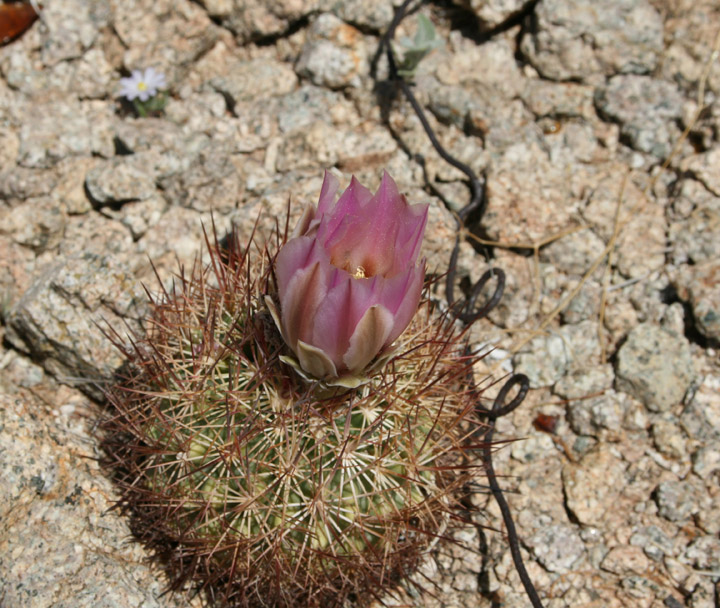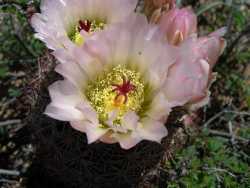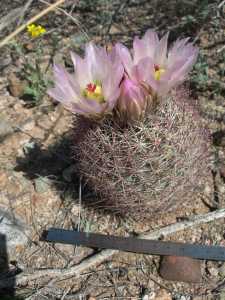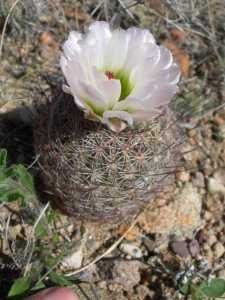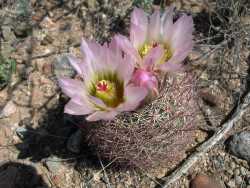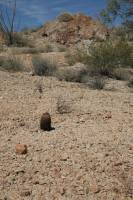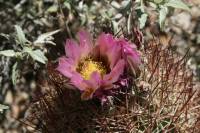
|
|
|
|
Family: Cactaceae
acuña cactus, more...Red-Spine Fish-Hook Cactus, redspine fishhook cactus
[Neolloydia erectocentra (Coult.) L. Benson, moreSclerocactus erectocentrus (Coult.) N.P. Taylor] |
Stems 4-34.5 × 4-10 cm; ribs 18-21; areoles 8-19 mm apart along ribs; areolar glands present at least seasonally. Spines 13-19 per areole, purplish pink to purple or nearly white with brown tips; radial spines 12-18 per areole; abaxial (shortest) radial spine 6-20 × 0.3-0.6 mm; adaxial and lateral (longest) radial spines 9-37 mm; central spines 1-3(-4) per areole (usually absent from sexually immature plants), erect to ascending, 12-44 × 0.5-0.8 mm; longest adaxial central spine straight to curved upward, abaxial central spine 13-35 mm (absent in var. erectocentrus). Flowers 3.6-6 × 4-9 cm; inner tepals whitish to bright rose-pink or lavender, basal portions olive-green to orangish brown, chestnut or maroon, (2-)2.5-4.3 × 0.6-1.8 cm; stigma lobes red to brownish red, papillae red or green. Fruits dehiscent by vertical slits, ellipsoid-cylindric, 12-20 × 5-8+ mm. 2n = 22. The populations of Echinomastus erectocentrus north of Tucson, Arizona, are geographically, ecologically, and morphologically intermediate between the two named varieties. Echinomastus erectocentrus is replaced to the northwest by E. johnsonii; the two species are only weakly differentiated.
FNA 2003 Common Name: redspine fishhook cactus Duration: Perennial Protected Status: Considered a very rare and endangered plant but it is not listed. General: A small upright cactus with singular stem that is 4-35.5 cm tall by 4-10 cm wide and generally cylindrical with 18-21 ribs that have areoles 8-19 mm apart along those ribs. Spines: At each areole there are 13-19 spines and they are purplish pink to purple but most have brown tips, there are 12-18 radial spines per areole with the radials ranging from 6-37 mm long and usually less than 1 mm in diameter, there are 1-3 central spines per areole which are absent from sexually immature plants, these are erect to ascending and 12-44 mm long. Flowers: Overall, they are 3.5-6 cm by 4-9 cm with whitish to bright rose pink tepals with a delicate stripe and olive green to orangish brown basal portions, the tepals are 2.5-4 cm long by 0.5-2 cm long, with red to brownish red stigma lobes, and numerous yellow anthers. Fruits: They are small and ellipsoid-cylindric and are dehiscent by vertical slits, 12-20 mm by 5-8 mm. Ecology: Found in desert grasslands of the Sonoran Desert Uplands on gravely bajadas and hills, generally on igneous and calcareous substrates from 1,500-5,000 ft (457-1524 m); flowers March-May. Notes: In our region there are two known varieties, var. erectocentrus and var. acunensis. The former is generally from 3,000 ft and higher while the latter is from 3,000 and below. Morphologically, they are distinguished by the inconspicuous central spines in var. erectocentrus and the rather conspicuous central spines in the other. Ethnobotany: Unknown Etymology: Echinomastus comes from from the Greek echinos, a hedgehog and masto for a breast, while erectocentrus comes from the Latin erectus for erect and centrum for center for the erect central spines. Synonyms: Echinocactus erectocentrus, Neolloydia erectocentra, Sclerocactus erectocentrus Editor: SBuckley 2011 |
This project was made possible in part by the Institute of Museum and Library Services [MG-70-19-0057-19].
Powered by Symbiota

